武当山英文简介
- 格式:doc
- 大小:12.00 KB
- 文档页数:1
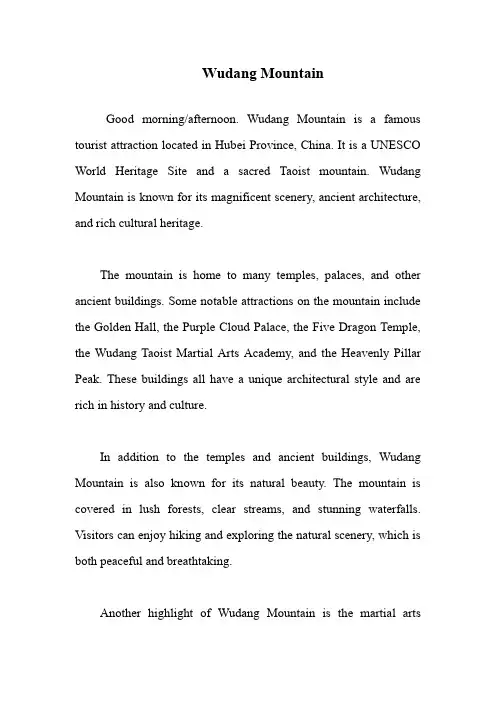
Wudang MountainGood morning/afternoon. Wudang Mountain is a famous tourist attraction located in Hubei Province, China. It is a UNESCO World Heritage Site and a sacred Taoist mountain. Wudang Mountain is known for its magnificent scenery, ancient architecture, and rich cultural heritage.The mountain is home to many temples, palaces, and other ancient buildings. Some notable attractions on the mountain include the Golden Hall, the Purple Cloud Palace, the Five Dragon Temple, the Wudang Taoist Martial Arts Academy, and the Heavenly Pillar Peak. These buildings all have a unique architectural style and are rich in history and culture.In addition to the temples and ancient buildings, Wudang Mountain is also known for its natural beauty. The mountain is covered in lush forests, clear streams, and stunning waterfalls. Visitors can enjoy hiking and exploring the natural scenery, which is both peaceful and breathtaking.Another highlight of Wudang Mountain is the martial artstraining that is offered. The Wudang Taoist Martial Arts Academy is a famous school that teaches traditional Chinese martial arts to students from all over the world. Visitors can take classes or watch demonstrations to learn more about the rich martial arts culture of China.Overall, Wudang Mountain is a must-visit destination for anyone interested in Chinese culture, history, and natural beauty. It is an unforgettable experience that offers a glimpse into one of the most important spiritual and cultural sites in China. That's all for my introduction of Wudang Mountain. If you have any questions about Wudang Mountain, feel free to ask me. Thank you!。
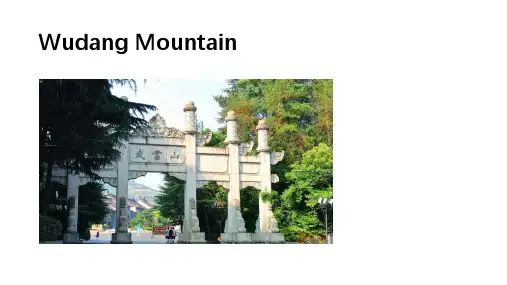
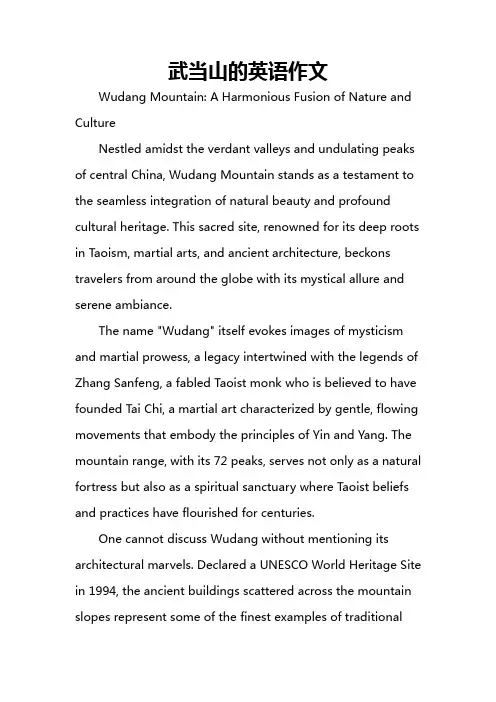
武当山的英语作文Wudang Mountain: A Harmonious Fusion of Nature and CultureNestled amidst the verdant valleys and undulating peaks of central China, Wudang Mountain stands as a testament to the seamless integration of natural beauty and profound cultural heritage. This sacred site, renowned for its deep roots in Taoism, martial arts, and ancient architecture, beckons travelers from around the globe with its mystical allure and serene ambiance.The name "Wudang" itself evokes images of mysticism and martial prowess, a legacy intertwined with the legends of Zhang Sanfeng, a fabled Taoist monk who is believed to have founded Tai Chi, a martial art characterized by gentle, flowing movements that embody the principles of Yin and Yang. The mountain range, with its 72 peaks, serves not only as a natural fortress but also as a spiritual sanctuary where Taoist beliefs and practices have flourished for centuries.One cannot discuss Wudang without mentioning its architectural marvels. Declared a UNESCO World Heritage Site in 1994, the ancient buildings scattered across the mountain slopes represent some of the finest examples of traditionalChinese palace and temple design. The structures, ingeniously blending with the surrounding landscape, showcase the philosophy of Feng Shui, where harmony between man-made structures and nature is paramount. The Palace of Harmony and Peace, the Golden Hall, and the Nanyan Temple are among the most revered, each adorned with intricate carvings and vibrant murals that narrate tales of deities and historical events.Wudang's spiritual significance extends beyond its physical structures. It is a living, breathing embodiment of Taoist teachings, where practitioners seek enlightenment through meditation, martial arts, and herbal medicine. The mountain's numerous temples serve as centers for learning and practice, attracting devotees and students who wish to immerse themselves in the study of Taoist scriptures, the art of Tai Chi, and other esoteric disciplines.Nature, too, plays a vital role in the Wudang experience. The lush forests, cascading waterfalls, and pristine streams create an atmosphere conducive to contemplation andself-reflection. Hiking along the winding paths, one encounters breathtaking vistas that inspire awe and humility. The area is also a haven for biodiversity, with numerousspecies of flora and fauna thriving within its protected confines.Wudang Mountain is more than just a destination; it is a journey into the heart of Chinese culture and spirituality. It embodies the harmonious coexistence of humanity and nature, the union of physical and spiritual pursuits, and the timeless wisdom of Taoist philosophy. For those seeking a glimpse into China's ancient past or desiring a spiritual retreat amidst natural splendor, Wudang Mountain offers a sanctuary unlike any other.。
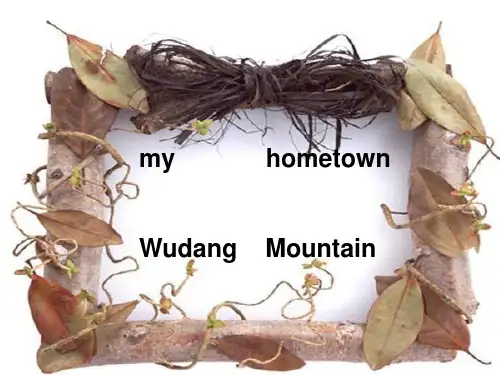
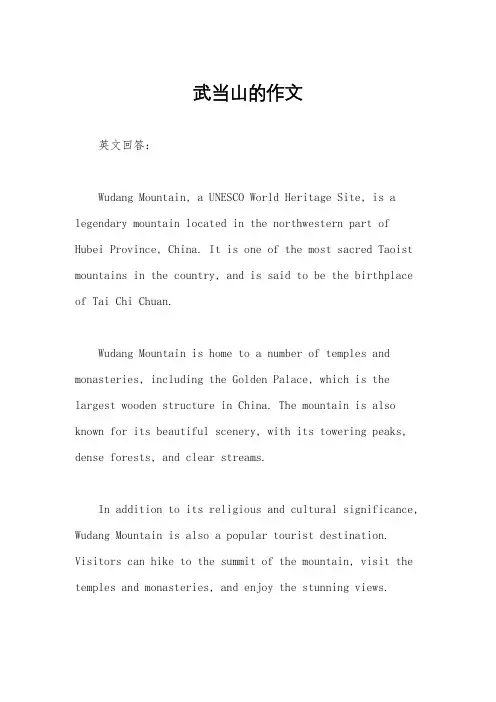
武当山的作文英文回答:Wudang Mountain, a UNESCO World Heritage Site, is a legendary mountain located in the northwestern part of Hubei Province, China. It is one of the most sacred Taoist mountains in the country, and is said to be the birthplace of Tai Chi Chuan.Wudang Mountain is home to a number of temples and monasteries, including the Golden Palace, which is the largest wooden structure in China. The mountain is also known for its beautiful scenery, with its towering peaks, dense forests, and clear streams.In addition to its religious and cultural significance, Wudang Mountain is also a popular tourist destination. Visitors can hike to the summit of the mountain, visit the temples and monasteries, and enjoy the stunning views.中文回答:武当山。
武当山,联合国教科文组织世界遗产,是中国湖北省西北部的一座传奇名山。
它是中国最神圣的道教名山之一,据说也是太极拳的发源地。
武当山拥有多座寺庙和道观,包括金殿,这是中国最大的木结构建筑。
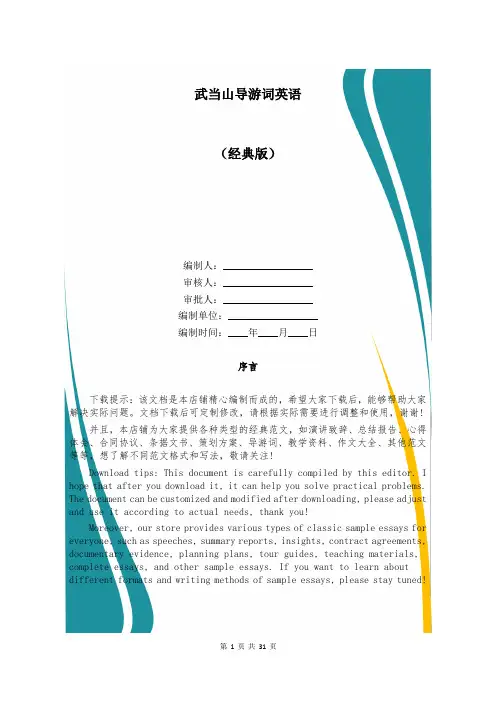
武当山导游词英语(经典版)编制人:__________________审核人:__________________审批人:__________________编制单位:__________________编制时间:____年____月____日序言下载提示:该文档是本店铺精心编制而成的,希望大家下载后,能够帮助大家解决实际问题。
文档下载后可定制修改,请根据实际需要进行调整和使用,谢谢!并且,本店铺为大家提供各种类型的经典范文,如演讲致辞、总结报告、心得体会、合同协议、条据文书、策划方案、导游词、教学资料、作文大全、其他范文等等,想了解不同范文格式和写法,敬请关注!Download tips: This document is carefully compiled by this editor. I hope that after you download it, it can help you solve practical problems. The document can be customized and modified after downloading, please adjust and use it according to actual needs, thank you!Moreover, our store provides various types of classic sample essays for everyone, such as speeches, summary reports, insights, contract agreements, documentary evidence, planning plans, tour guides, teaching materials, complete essays, and other sample essays. If you want to learn about different formats and writing methods of sample essays, please stay tuned!武当山导游词英语武当山周边高峰林立,天柱峰海拔1612米。
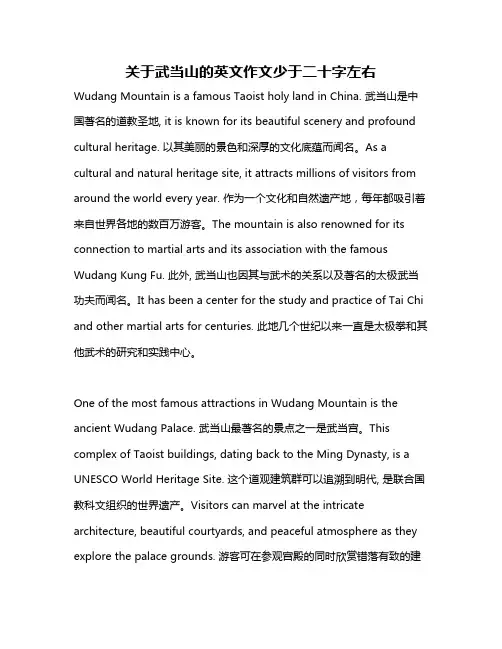
关于武当山的英文作文少于二十字左右Wudang Mountain is a famous Taoist holy land in China. 武当山是中国著名的道教圣地, it is known for its beautiful scenery and profound cultural heritage. 以其美丽的景色和深厚的文化底蕴而闻名。
As a cultural and natural heritage site, it attracts millions of visitors from around the world every year. 作为一个文化和自然遗产地,每年都吸引着来自世界各地的数百万游客。
The mountain is also renowned for its connection to martial arts and its association with the famous Wudang Kung Fu. 此外, 武当山也因其与武术的关系以及著名的太极武当功夫而闻名。
It has been a center for the study and practice of Tai Chi and other martial arts for centuries. 此地几个世纪以来一直是太极拳和其他武术的研究和实践中心。
One of the most famous attractions in Wudang Mountain is the ancient Wudang Palace. 武当山最著名的景点之一是武当宫。
This complex of Taoist buildings, dating back to the Ming Dynasty, is a UNESCO World Heritage Site. 这个道观建筑群可以追溯到明代, 是联合国教科文组织的世界遗产。
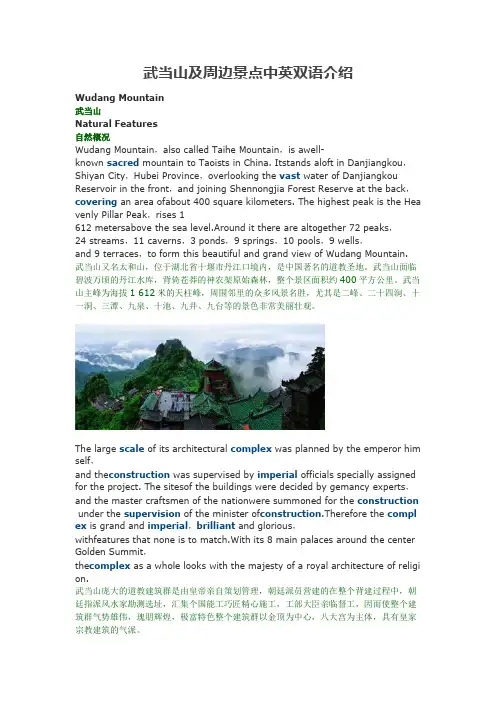
武当山及周边景点中英双语介绍Wudang Mountain武当山Natural Features自然概况Wudang Mountain,also called Taihe Mountain,is awell-known sacred mountain to Taoists in China. Itstands aloft in Danjian gkou,Shiyan City,Hubei Province,overlooking the vast water of Danjiangkou Reservoir in the front,and joining Shennongjia Forest Reserve at the back,covering an area ofabout 400 square kilometers. The highest peak is the Hea venly Pillar Peak,rises 1612 metersabove the sea level.Around it there are altogether 72 peaks,24 streams,11 caverns,3 ponds,9 springs,10 pools,9 wells,and 9 terraces,to form this beautiful and grand view of Wudang Mountain.武当山又名太和山,位于湖北省十堰市丹江口境内,是中国著名的道教圣地。
武当山面临碧波万顷的丹江水库,背倚苍莽的神农架原始森林,整个景区面积约400平方公里。
武当山主峰为海拔1 612米的天柱峰,周围邻里的众多风景名胜,尤其是二峰、二十四涧、十一洞、三潭、九泉、十池、九井、九台等的景色非常美丽壮观。
The large scale of its architectural complex was planned by the emperor him self,and the construction was supervised by imperial officials specially assigned for the project. The sitesof the buildings were decided by gemancy experts,and the master craftsmen of the nationwere summoned for the construction under the supervision of the minister of construction.Therefore the compl ex is grand and imperial,brilliant and glorious,withfeatures that none is to match.With its 8 main palaces around the center Golden Summit,the complex as a whole looks with the majesty of a royal architecture of religi on.武当山庞大的道教建筑群是由皇帝亲自策划管理,朝廷派员营建的在整个背建过程中,朝廷指派风水家勘测选址,汇集个国能工巧匠精心施工,工部大臣亲临督工,因而使整个建筑群气势雄伟,瑰朋辉煌,极富特色整个建筑群以金顶为中心,八大宫为主体,具有皇家宗教建筑的气派。
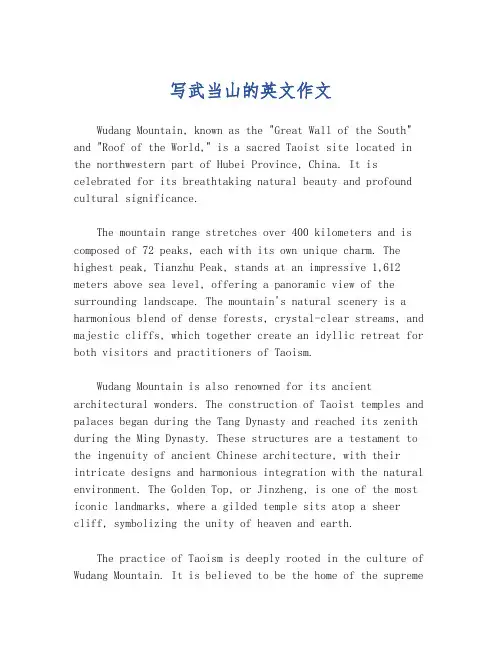
写武当山的英文作文Wudang Mountain, known as the "Great Wall of the South" and "Roof of the World," is a sacred Taoist site located in the northwestern part of Hubei Province, China. It is celebrated for its breathtaking natural beauty and profound cultural significance.The mountain range stretches over 400 kilometers and is composed of 72 peaks, each with its own unique charm. The highest peak, Tianzhu Peak, stands at an impressive 1,612 meters above sea level, offering a panoramic view of the surrounding landscape. The mountain's natural scenery is a harmonious blend of dense forests, crystal-clear streams, and majestic cliffs, which together create an idyllic retreat for both visitors and practitioners of Taoism.Wudang Mountain is also renowned for its ancient architectural wonders. The construction of Taoist temples and palaces began during the Tang Dynasty and reached its zenith during the Ming Dynasty. These structures are a testament to the ingenuity of ancient Chinese architecture, with their intricate designs and harmonious integration with the natural environment. The Golden Top, or Jinzheng, is one of the most iconic landmarks, where a gilded temple sits atop a sheer cliff, symbolizing the unity of heaven and earth.The practice of Taoism is deeply rooted in the culture of Wudang Mountain. It is believed to be the home of the supremeTaoist deity, the Jade Emperor, and is a place where Taoist monks have practiced their spiritual disciplines for centuries. The martial arts, especially Tai Chi, which originated here, are an integral part of the Taoist philosophy, emphasizing the balance between mind and body, and the harmony with the universe.Visiting Wudang Mountain is an enriching experience that offers not only a feast for the eyes but also a journey into the heart of Chinese Taoist culture. The serenity of the mountain, the wisdom of its teachings, and the legacy of its history continue to inspire and captivate those who venture to explore its sacred grounds.。
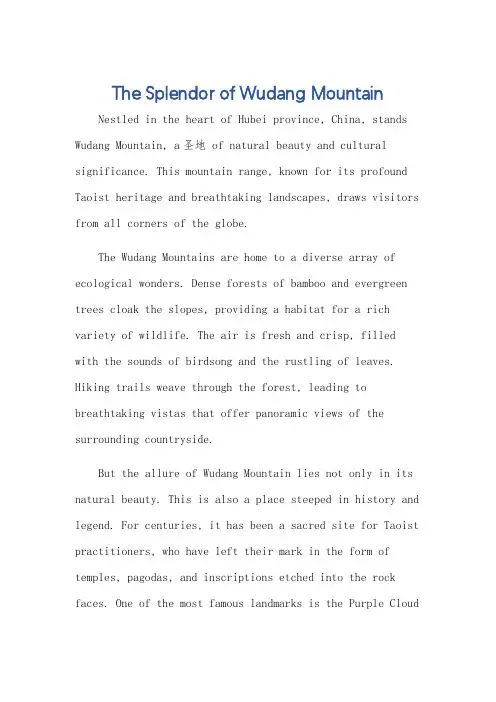
The Splendor of Wudang MountainNestled in the heart of Hubei province, China, stands Wudang Mountain, a圣地 of natural beauty and cultural significance. This mountain range, known for its profound Taoist heritage and breathtaking landscapes, draws visitors from all corners of the globe.The Wudang Mountains are home to a diverse array of ecological wonders. Dense forests of bamboo and evergreen trees cloak the slopes, providing a habitat for a rich variety of wildlife. The air is fresh and crisp, filled with the sounds of birdsong and the rustling of leaves. Hiking trails weave through the forest, leading to breathtaking vistas that offer panoramic views of the surrounding countryside.But the allure of Wudang Mountain lies not only in its natural beauty. This is also a place steeped in history and legend. For centuries, it has been a sacred site for Taoist practitioners, who have left their mark in the form of temples, pagodas, and inscriptions etched into the rock faces. One of the most famous landmarks is the Purple CloudPalace, a magnificent structure that stands as a testamentto the辉煌历史 of Taoism in this region.The cultural influence of Wudang Mountain extends beyond its physical boundaries. It is the birthplace of Wudang martial arts, a unique style of martial arts that combines the principles of Taoism with the physical disciplines of martial arts. This blend of spirituality and physicality is what gives Wudang martial arts itsdistinctive character and worldwide reputation.The spirit of Wudang Mountain is captured in theserenity of its temples and the tranquility of its forests. It is a place where one can find inner peace and connectwith nature. Visitors are often moved by the profound sense of spirituality that permeates the air, making their visitto Wudang Mountain a transformative experience.The Wudang Mountains are not just a tourist destination; they are a sacred ground that holds a special place in the hearts of many. They offer a unique blend of natural beauty, cultural heritage, and spiritual enlightenment that is unparalleled in its charm and allure.**武当山的辉煌**位于中国湖北省心脏地带的武当山,是自然美景与文化底蕴的圣地。
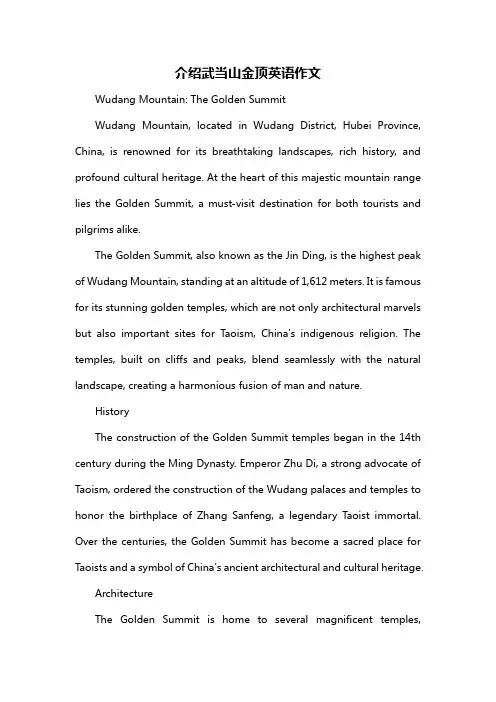
介绍武当山金顶英语作文Wudang Mountain: The Golden SummitWudang Mountain, located in Wudang District, Hubei Province, China, is renowned for its breathtaking landscapes, rich history, and profound cultural heritage. At the heart of this majestic mountain range lies the Golden Summit, a must-visit destination for both tourists and pilgrims alike.The Golden Summit, also known as the Jin Ding, is the highest peak of Wudang Mountain, standing at an altitude of 1,612 meters. It is famous for its stunning golden temples, which are not only architectural marvels but also important sites for Taoism, China's indigenous religion. The temples, built on cliffs and peaks, blend seamlessly with the natural landscape, creating a harmonious fusion of man and nature.HistoryThe construction of the Golden Summit temples began in the 14th century during the Ming Dynasty. Emperor Zhu Di, a strong advocate of Taoism, ordered the construction of the Wudang palaces and temples to honor the birthplace of Zhang Sanfeng, a legendary Taoist immortal. Over the centuries, the Golden Summit has become a sacred place for Taoists and a symbol of China's ancient architectural and cultural heritage.ArchitectureThe Golden Summit is home to several magnificent temples,including the Hall of the Golden Roof, the Hall of Praying for Good Fortune, and the Hall of the Unity of Heaven and Man. These temples feature intricate woodcarvings, glazed tiles, and stunning gilded roofs, which gleam under the sunlight, giving the summit its namesake.The Hall of the Golden Roof, the most iconic structure on the Golden Summit, is a masterpiece of Ming Dynasty architecture. It has a double-eaved golden roof, symbolizing the supreme status of Taoism in ancient China. The hall houses a statue of Zhang Sanfeng, as well as numerous other deities and immortals.Cultural SignificanceThe Golden Summit is not only a place of worship but also a center for the study and practice of Taoism. Many Taoist rituals and festivals are held here throughout the year, attracting pilgrims and tourists from far and wide. The summit is also a popular destination for martial arts enthusiasts, as Wudang is considered the birthplace of Wudang Boxing, an influential branch of internal martial arts.Visiting the Golden SummitTo reach the Golden Summit, visitors can either hike up the mountain or take a cable car. The hike offers stunning views of the surrounding landscape, while the cable car provides a convenient and scenic route to the top. Once at the summit, visitors can explore the temples, admire the architecture, and enjoy the peaceful atmosphere.In conclusion, the Golden Summit of Wudang Mountain is a place of immense cultural and historical significance. Its stunning temples, breathtaking scenery, and rich Taoist heritage make it an unforgettable destination for all who visit.。
武当山的英语作文【篇一:武当山的英文介绍】the wudang mountains, also known as wu tang shan or simply wudang, are a small mountain range in the hubei province of china, just to the south of the manufacturing city of shiyan.in years past, the mountains of wudang were known for the many taoist monasteries to be found there, monasteries which became known as an academic centre for the research, teaching and practise of meditation, chinese martial arts, traditional chinese medicine, taoist agriculture practises and related arts. as early as the eastern han dynasty (25–220 ad), the mountain attracted the emperors attention. during the tang dynasty (618–907), the first site of worship—the five dragon temple—was constructed. the monasteries were emptied, damaged and then neglected during and after the cultural revolution of 1966–1976, but the wudang mountains have lately become increasingly popular with tourists from elsewhere in china and abroad due to their scenic location and historical interest. the monasteries and buildings were made a unesco world heritage site in 1994. the palaces and temples in wudang, which was built as an organized complex during the ming dynasty (14th–17th centuries), contains taoist buildings fromas early as the 7th century. it represents the highest standards of chinese art and architecture over a period of nearly 1,000 years. noted temples include the golden hall, nanyan temple and the purple cloud temple.【篇二:武当山英文导游词】today we’ll visit the famous s acred place of taoism-----wudang mountain. now i would like to outline the general situation of this mountain. it is not only one of the first batch([b?t?])national level scenic spots (首批国家级旅游景点)of china but also the heritage of the world. wudang mountain, also known as taihe mountain, is located in shiyan city, northwest of hubei province. in the late period of the easten han dynasty, taoism道教 was born and wudang mountain was respected as the immortal 不朽的([im?:t?l]) mountain of taoism.besides the refined(微妙的) and elegant natural sceneries , the ancient architectures are grandnow we’ve reached our destination---wudang mountain. a few minutes later, we will reach our first station----the needle-rubbing well.the buildings of the needle-rubbing well were located at a high point. according to wudang taoism, it was this exact point that receives the first beam of pure positive sunshine when the sun rises every day, so it is also called pure sunshine palace.now we are in the taizipo zone. the building in front of us isthe needle-rubbing well. let’s get off the bus. the needle-rubbing well is a typically exquisite精美的 [ekskwizit]buildingin wudang mountain, whose overall arrangement is supremely ordered and beautiful她的整体布局极度的美丽而有序, and tells about the story of zhenwus trainingit is said that zhenwu, crown prince of jing le country, went to wudang mountain to train himself at the age of 15.after self- training in the deep forest for several decades but achieved nothing, he was totally depressed and decided to go back to the secular world; however when he came here and met an old woman, rubbing a ferrous [fer?s] pestle to get a needle, which madehim realize that perseverance [,p?:si:vi?r?ns] will prevail [priveil so he came back to the deep forest to continue hisself-training and finally he became a god.entering the gate, you will see a group of smart and exquisite buildings, without symmetrical独特的 [simetrik?l] arrangement, but with a unique style and layout, which allow you to easily distinguish the primary and secondary ones.let’s get on the bus and go to our next station----purple cloud palce. before my description of this scenic spot, you can draw a picture of the palace in your mind with imagination.in the middle of the shrine dedicated the image of zhenwu.with a height of 4.8meters, the image is the biggest clay sculpture. another divine神圣的 image made by paper and covered with golden leaves is the best preserved 保存[priz?:vd] and most ancient paper image ,which comprehensively displays广泛地,最大程度地展示了 the marrow精华oncraftwork of paper pasting裱糊[peisti?], sculpting, gilding镀金, colored drawing, and has great value in researchingancient paper pasting.the fastigium屋脊 of the grand hall consists of six flying colored glaze彩釉 [gleiz] dragons. an aquarius is surrounded by the dragons that are painted in three different colors. due to the heaviness and highness, the aquarius has to be drawn by four iron [ar?n] chains [t?ein]铁链. each end of the chain is attached to the hand of a divine kid, it is said that the four kids of deity神明after the rebuilding in 1412 a.d., the grand hall had been repaired about ten times in different times. therefore, it can maintain its basic features. in 1994, the experts on world’s relics from un inspected wudang mountain and said, here, we witness the sample of traditional remedial治疗[rimi:di?l,means to the ancient buildings.now we are leaving for the golden summit, which is regarded as the symbol of the wudang mountain .we will go there by tram rail索道. now we have got to the st ation. let’s get of the bus and get on the tram rail. on the way to golden peak by tram rail, we are now traveling among the peaks, and then we are floating in the clouds, just like gods. we have reached the main peak .it is 1612 meters high. the golden palace is located here. standing in front of the golden palace, you can have overall view of the beautiful scene of wudang mountain,。
武当山导游词英语武当山导游词英语作为一名优秀的导游,总不可避免地需要编写导游词,导游词是导游员进行实地口语导游的基础和前提。
我们应该怎么写导游词呢?下面是小编帮大家整理的武当山导游词英语,供大家参考借鉴,希望可以帮助到有需要的朋友。
武当山导游词英语1Hello everyone! I'm very happy to serve you. If you have any questions, please feel free to ask. We will try our best to solve them for you. You can call mex guide.At this moment, our journey to Wudang Mountain is about to begin.Wudang Mountain is located in Danjiangkou City, which is under the jurisdiction of Shiyan City, northwest town of Hubei Province. It is famous for its Taoist Holy Land and world cultural heritage, with Xiangfan in the East, Shennongjia in the south, Shiyan in the West and Danjiangkou Reservoir in the north.The peculiar natural landscape of Wudang Mountain always fascinates people. The main scenic spots are: 72 peaks, 36 rocks, 24 streams, 11 caves, three pools, nine springs, ten stones, nine wells, nine palaces, nine temples, etc.There are more than 50 legends about Wudang Mountain. Among them are wenmu bridge, the first mountain, heart testing stone, Guanmen mountain, Longtou incense, etc.In front is the cliff hanging Palace - Nanyan palace, please don't come forward.At this moment, we understand "Wudang fairyland, mysterious and ethereal." "Wudang culture is the soul of China." "Wudang Wushu is mysterious and wonderful."This is the end of our tour guide. I hope you can enjoy our Wudang Mountain.武当山导游词英语2Dear touristsHello everyone! I'm Tian Kunlin, a little guide with red scarf. Next, I'll show you around Wudang Mountain. As the saying goes, "when the five mountains return, you don't see the mountains, when the Yellow Mountains return, you don't see the mountains." Although I haven't visited Huangshan, the scenery of Wudang Mountain is certainly comparable to Huangshan. Let me show you around today.Wudang Mountain has beautiful scenery and dangerous peaks. It is composed of more than ten scenic spots, such as Xiaoyao Valley, taizipo, Huangyan, etc. It is said that a snake and a tortoise fought together long ago. Later, a flying star combined the snake and the tortoise into one, forming the present Wudang Mountain. Looking at Wudang Mountain from the plane, it was a turtle with a big snake lying on it.We have arrived at the first scenic spot, Prince slope. Let's get off the bus with me to visit Prince slope. Prince slope has a main hall, 13 pillar houses, 23 small halls. The most peculiar is that there is a sound transmission function on the red wall of taizipo. We go down the mountain and walk a few miles to Xiaoyao valley. There are lots of woods in Xiaoyao valley. There are many little monkeys in the woods. If you feed them, they will go to the trees and pick delicious fruits for you. There will be a scene of human and animal sharing happiness. You can also go to the clear brook to watch, wash your face, rest for a while and then move forward.Walk a few more miles to the foot of Huangyan mountain.There is a flying stone on the yellow rock and two big fingerprints on it. It's said that once upon a time, a stone flew to the mountain. If it didn't support the stone, it would collapse the mountain. At this time, the Taoist priest of Wudang Mountain came here with both hands to prevent the stone from collapsing the whole mountain. Later, he left this seal. There is also a kind of tea on the mountain, which will keep sweet for a long time as long as you don't eat. Drinking mineral water is also sweet, and you can taste it for free.That's all for today's tour guide. Please come again. Goodbye. Wudang Mountain is really beautiful. I hope you have a chance to enjoy it.武当山导游词英语3Dear touristsI'm very happy to be your guide today. When you know that Wudang Mountain is a famous Taoist mountain, you can feel that the fresh air nourishes your body and relieves your fatigue. Do you know what this means? This is a gift of health and longevity given by Wudang people when they welcome you. I hope you can enjoy it during your visit to Wudang Mountain To the Sutra of prolonging life. Well, let me give you a brief introduction to Wudang Mountain.The situation of Wudang MountainWudang Mountain, also known as Taihe mountain, is located in Danjiangkou City, Shiyan City, Hubei Province. Neijiaquan is a famous Taoist Holy Land in China. It is the birthplace of neijiaquan. With its gorgeous natural scenery, rare ancient architecture, profound Taoist culture and mysterious Wudang martial arts, it forms an ideal fairyland of Taoism and the unity of heaven and man. They are listed as "national key cultural relicsprotection units, national key scenic spots, National Wushu hometown, national 4A tourist area and world cultural heritage" respectively.Around eight hundred million BC, the mountain rose from the ancient ocean. About thirty thousand years ago, the Indochina plate collided with the Eurasian continent, the Qinghai Tibet Plateau rose strongly, and the Wudang Mountains and the Dabashan Mountain Rose simultaneously, making it an integral part of the second steps of our country. The main peak, Tianzhu peak, stands at 1612 meters above sea level, straight into the sky, and the rest of the peaks vie for greatness and wonder. It integrates the beauty of Emei, the danger of Huashan, the seclusion of Lushan, and the greatness of Huangshan into one, forming a magnificent landscape with the main feature of strangeness, masculinity, danger, seclusion, and beauty. It was worshipped by countless literati and poets, and by emperors of all dynasties. The great calligraphers of Song Dynasty praised it as "the first mountain", and the Yongle Emperor of Ming Dynasty named it "the great mountain Taihe mountain", which means that Wudang Mountain is not among the five mountains, but it is above them. Wudang Mountain is backed by Daba Mountain of Qinling Mountains, facing the broad Jianghan Plain, with the Han River stretching thousands of miles on the left and the Yangtze River flowing thousands of miles on the right.The peculiar natural landscape of Wudang Mountain always fascinates people. The main scenic spots are: 72 peaks, 36 rocks, 24 streams, 11 caves, 3 pools, 9 springs, 10 stones, 9 wells, 9 palaces, 9 temples, 36 nunneries, 72 rock temples, etc. Wudang Mountain is located in the hinterland of central China with a pleasant climate. Animals and plants from north and South cangrow and multiply here. In spring, the mountains are green and the flowers are beautiful; in summer, the wind and thunder are stirring and the clouds are shrouded; in autumn, the trees are sparse and the leaves are red and fresh; in winter, icicles are propping up the sky and Qiongyao are everywhere. Wang Shizhen, a writer of the Ming Dynasty, praised Wudang Mountain highly: "the victory of the mountain is the best in the world.".Wudang Wushu is a famous school of Chinese Wushu, known as "Shaolin in the north, Wudang in the South". Neijiaquan founded by Zhang Sanfeng has its own system of Taiji, Xingyi and Bagua due to the inheritance and development of celebrities in the past dynasties. Especially Taijiquan has a wide range of development with its own characteristics. It has formed many schools, such as Chen style, Yang style, sun style, Wu style, etc Fitness, self-defense, longevity for the purpose, widely accepted by people, is the most precious cultural heritage of all mankind. According to statistics, there are nearly 500 million people practicing Taijiquan all over the world. As the ancestor of Taijiquan, Wudang Mountain shoulders the historical responsibility of inheritance and promotion. On May 26, 1999, when Comrade Jiang Zemin inspected Wudang Mountain, he said: Wudang boxing is good. Everyone should practice it and keep fit.Wudang Mountain is known as the "natural medicine storehouse". Li Shizhen, a medical scientist in Ming Dynasty, visited famous mountains and rivers all over the world and found Mantuoluo flower in Wudang Mountain, which solved a big problem of Chinese surgical anesthetics shortage. He also recorded more than 400 kinds of Wudang Mountain herbs in compendium of materia medica. Wudang Mountain's famousherbs include seven leaves and one branch of flower, one pearl on the head, a bowl of water by the river and a pen by King Wen And so on, Huangjing, Ganoderma lucidum, golden fork and other precious medicinal materials were all tributes in the Imperial Palace at that time.When you come to Wudang Mountain, you can not only visit mountains, but also play with water. The largest man-made freshwater lake in Asia is located at the foot of Wudang Mountain. It is like a colorful ribbon that makes Wudang Mountain look enchanting. The mountains and rivers are connected, and they are each other's wonders. The lakes and mountains echo each other from afar. The middle route of South-to-North Water Diversion lies here. In the Ming Dynasty, Wudang was built in the South and the Forbidden City was built in the north. In the present period, the vast projects of "Wudang South Water Diversion" and "Beijing for North Water Diversion" have been carried out. History always acts as a matchmaker (beauty), linking Beijing with Wudang Mountain and forming an indissoluble bond.Hello, everyone. Welcome to our hotel. My name is Yu. As people often say, meeting is fate. I feel very honored to meet you in the beautiful Jiangcheng and spend this wonderful time with you. This is our driver, Master Wang. We will serve you today. If you have any questions, you can raise them. We will try our best to help you solve them. We hope to exchange our enthusiasm, patience and carefulness for your confidence and happiness.Today, I will take you to visit Wudang Mountain. Let's enjoy its beautiful natural scenery and rich Taoist culture.The situation of Wudang MountainWudang Mountain is located in Danjiangkou City, HubeiProvince. The Danjiangkou reservoir, facing the rippling blue waves, is backed by the vast Shennongjia forest region, covering more than 400 kilometers. The scenery here is beautiful, and the four seasons are different: prosperous in spring, lush mountains in summer, fragrant osmanthus in autumn and white snow in winter. No matter when we come, we can appreciate her beauty. There is a saying that "the world's famous mountains are occupied by Buddhas", but in Wudang Mountain, Taoism dominates the world. It is said that the Golden Summit of Wudang Mountain was originally occupied by Wuliang Buddha. Later, Emperor Zhenwu was able to cultivate immortals and traveled here. He saw that there were many peaks here. Tianzhu peak, the main peak, towered into the clouds. Around 72 peaks, he bent over each other, forming a spectacle of "72 peaks facing the great summit". Emperor Zhenwu fell in love with this treasure land, so he went to Tianzhu peak to discuss with Wuliang Buddha about borrowing the land, and proposed to borrow only eight steps. When Wuliang Buddha saw that he didn't have much, he agreed. Unexpectedly, Emperor Zhenwu had boundless power. He took eight steps from the top of Tianzhu peak, 100 Li at a time. Eight steps actually took the whole of Wudang and won the right of permanent residence. Therefore, Wudang Mountain became the site of Taoism.It's not only the incense resort of Taoism, but also the hometown of Wudang boxing. There has always been a saying in Chinese Wulin that "Shaolin in the north, Wudang in the South". Many people do not know Wudang Mountain but know Wudang boxing. It is said that the founder of Wudang boxing is Zhang Sanfeng, a famous Taoist in the Ming Dynasty. I think friends who like martial arts may know something about this through novels.It is said that when he was practicing here, he saw the scene of fighting between cranes and snakes. He was inspired and realized the thirteen forms of Tai Chi. Therefore, he was respected as the founder of Wudang school.Having said so much, I think you can't wait. Now that we are at the foot of Wudang Mountain, please take your belongings and get out of the car to start our pilgrimageZixiao PalaceNow the green glazed tile hall in front of us is Zixiao palace. Because the hills around this place naturally formed a treasure chair for Erlong Xizhu, and Emperor Yongle named it "Zixiao blessed land". In the shrine on the stone Xumi seat in the hall, the statues of Zhenwu God in old age, middle age and youth and the sitting statues of Wenwu immortal are worshipped. They are different in shape and lifelike, which are the art treasures of Ming Dynasty. It is said that the fir which is several feet long on my right hand side suddenly came from afar, so it is called Feilai fir. It is said that if you tap one end of the fir, you can hear a clear sound at the other end, so it is also called xianglingshan. As for why it flies here, I think it is also attracted by its beautiful scenery Nan YanThere are 36 rocks in Wudang Mountain. Now we come to Nanyan, which is considered to be the most beautiful of the 36 rocks. Wudang Mountain's natural landscape and exquisite architecture are integrated, which can be fully reflected here. The stone hall on the cliff was built in the Yuan Dynasty. There is a carved dragon stone beam beside the cliff. The stone beam stretches out 2.9 meters and is only 30 cm wide. The top of the dragon head is carved with a censer, which is the famous "dragon head incense". In the past, some pilgrims risked their lives to burnLongtou incense to show their piety, which shows their deep belief in Taoism. For the sake of safety, if we all want to make a wish and pray, we can go to other places. If we are sincere, we will be wise(for example, 36 rock in Wudang Mountain is a great spectacle. What we see now is the most beautiful Nanyan rock among 36 rocks. This stone hall, which stands on the edge of Nanyan cliff, was built in the Yuan Dynasty. On the edge of the cliff of the stone hall, this small building is carved dragon stone beam. The stone beam stretches out 2.9 meters in the air and is only 30 cm wide. There is a dragon carved on the stone beam and a censer carved on the top of the dragon head. This is the stone hall The famous "dragon head incense", it leaps out of the sky, next to the deep valley, has a high artistic and scientific. In the past, some pilgrims risked their lives to burn Longtou incense to show their piety. It can be seen that they have a deep faith in Taoism. Because they are close to the abyss, for safety's sake, if you want to make a wish, you can go to other places, because if you are sincere, you will be wise. ))Tianzhu peak (Jinding)After a lot of efforts, we finally climbed the main peak Tianzhu peak. Tianzhu peak is 1612 meters above sea level, known as "a pillar of heaven". Standing here, you can clearly see the spectacular scene of "72 peaks facing the top". And the golden palace on the top of Tianzhu peak is the golden palace. Jindian is the largest gilded hall in China, built in the 14th year of Yongle. The whole golden hall didn't use a nail. It was made by casting all the parts and then transporting them up the mountain. The mortars and mortars were very tight. It seemed to be an integral whole. Look, it's said that the ever burning lamp herenever goes out. So the mountain top is open and windy. Why can't it be blown out by the wind? It's said that it's because of the "fairy bead" on the caisson. It is said that this fairy bead can suppress the mountain wind and prevent the wind from blowing into the hall, thus ensuring the brightness of the magic lamp. In fact, the real reason why the lamp is always bright is that all the castings of the temple door are very strict and accurate, which can change the direction of the wind. This shows the wisdom and skills of the ancient working people in China(dear tourists, the glittering statues you see now are in the stone hall. They also bear witness to the historical and artistic value of the stone hall, which is full of Taoist culture. We generally follow a bottom-up route. Looking back at Nanyan, after some efforts, we have now climbed the Tianzhu peak with an altitude of 1612 meters, which is known as "one pillar supporting the sky": if you stand on Tianzhu peak, you can clearly see the spectacular scene of "seventy-two peaks towards the top", and on the top of Tianzhu peak stands a magnificent palace, that is everyone Now you can see the golden hall. It is another famous palace in Wudang Mountain. The golden hall is China's largest Hall of steel casting and gold gilding. It was built in the 14th year of Yongle. The whole golden hall was built without a nail. It was all cast and then transported up the mountain. It was riveted tightly. It looks like an integral whole. You can also enter the hall to pray for happiness and health. ))OK, everybody follow me to Jinding. Now it's Nantianmen. There are three doors in Nantianmen. Why don't the two doors open? There's something particular about it. In the middle is the gate of heaven, also known as the gate of God, where God goes in and out. Mortals can't go, only emperors, Queens, princes andgrandchildren can. A door over there is a ghost door. Of course, the ghost door can't be opened to let people go. The door we go through is called "people's door".Well, friends, we are now standing on the top of the Golden Summit to see the clouds floating and the mountains coming. It's spectacular. It's interesting to see all the mountains are small. Every peak inclines to Jinding, so there are 72 peaks facing Dading. Here, you can enjoy the natural Xuanwu, which is made up of Jinding, Taihe palace, Tianzhu peak, the Forbidden City wall, and the surrounding mountains. It is both mysterious and ingenious.The main building in Jinding is Jindian. On the left is qianfang and on the right is Xiangfang. The golden hall is the essence of Wudang Mountains. Ming Chengzu's concern for the golden hall can be said to be meticulous. He personally arranged every link from the casting of the Golden Hall components to the escort installation. According to the craftsman's principle, the hall is made of copper, with double eaves and double archesx With the imperial edict of "golden fan, gold statue of Emperor Xuan, left and right Lingguan, jade girl, holding sword to hold flag and sky general", after casting all the components in Beijing, He Jun, the imperial governor, issued the imperial edict on the ninth day of September in the fourteenth year of Yongle (1416): "today I will escort the ships of the golden hall to Nanjing, and the ships along the way should be careful. When the sky is clear, feng shui will go smoothly. The ship should be very clean. Therefore, the imperial edict was issued From the canal to the Yangtze River and Hanjiang River in Nanjing, the components were escorted to Wudang Mountain, then tenoned and welded.On the top of Tianzhu peak, the peak of Wudang, stands apalace like building with bronze gilding and wood imitation structure. This splendid and dazzling palace built in the Ming Dynasty weighs more than 100 tons, which is unique in the world. How was such a huge integral component cast and transported to the peak of 1612m?The golden hall and statues are national first-class cultural relics, which are very precious. There are 7.44 taels of gold per square meter. After 400 years of history, they are still brilliant. There are many magical legends and true stories about the golden palace. An oil lamp was lit in the 14th year of Yongle in the Ming Dynasty (1416). No matter how strong the wind is, it is always full of flames. It never shakes and never goes out. It has continued to this day. It hasn't been put out for more than 600 years. This lamp is dedicated to the altar in the golden hall. It is the lamp under the bead of Dingfeng fairy in journey to the west, in which Monkey King visits Wudang Mountain and asks Xuanwu emperor for help. Is Dingfeng Xianzhu able to suppress the mountain breeze, or is it due to other reasons that the magic lamp has remained bright for more than 500 years? In fact, the structure of the golden hall is ingenious, airtight and can not form convection, so the lamp will not go out naturally.In order to prevent people from stealing from the golden hall, it is said that Thor often visits the golden hall and washes the hall with electricity and fire to warn villains that if they dare to steal from emperor Zhenwu, they will not be spared. Under the lightning strike, the golden hall is as new as ever. Surprisingly, the golden hall is not damaged by lightning strike. The secret of this is difficult for ordinary people to understand. This is the famous "thunder fire Lian Dian" spectacle. "Thunder fire refining hall", that is, the fireball formed by lightning rolling on the golden hall,is very spectacular.Transit HallNow, we're at the transit hall. Zhenwu, Jintong, Yunv and Shuihuo are worshipped in the hall. They are all made of copper and gilded with exquisite workmanship. This bronze hall was cast in Wuchang in the Yuan Dynasty and is the oldest existing one in China. It is known as "the first copper hall in China". It has the style of Buddhist architecture, but it is skillfully combined with Taoist architecture, and is regarded as "transit hall" by countless believers. How did the first copper hall in China become the palace of the palace? Let's guess. The reason why this hall is called transshipment hall is that people are looking forward to good luck. I hope my friends who are always lucky can go in and walk around, and remind them that when you walk around, you will hear the old Taoist priest ask, "did you turn around?" you should shout "turn around, turn around." Luck will turn better and better with you.Concluding remarksWudang Mountain stretches eight hundred Li. Dear tourist friends. After visiting Wudang Mountain, the "fairy mountain Pavilion" with high peaks and cloud all the year round, are you interested in the majestic momentum of the mountains and the Taoist culture with secluded immortal bonesx Today's explanation can make you have a deeper impression on Wudang Mountain. Finally, I wish you all happiness, good luck and a happy family!武当山导游词英语4#Hello, tourists. I'm your tour guide of Wudang Mountain. You can call me Xiao Zhu. Here, on behalf of our travel agency, I would like to extend my warmest welcome to you all. Next to thisis our driver master --- Master Li. Master Li has ten years of driving experience and skillful driving skills, so you can rest assured to ride. In the next journey, we will try our best to bring you the best service. I hope you can have a good time on this day.Wudang Mountain, also known as Taihe mountain, is located in Shiyan City, Hubei Province. It is a famous Taoist Holy Land and the birthplace of Wudang boxing. There are many peaks, the main peak is Tianzhu peak, and the surrounding 72 peaks face each other, forming a lotus shaped mountain system and a spectacle of "72 peaks facing the top", which is rare in other famous mountains in China.There is a saying that "the world's famous mountains are occupied by Buddhas", but in Wudang Mountain, Taoism dominates the world. Wudang Mountain gets its name from "it can't be regarded without real martial arts". Zhenwu is the great emperor of Zhenwu. He practiced here.Wudang Taoist temple was built in Zhenguan period of Tang Dynasty and reached its peak in Yongle period of Ming Dynasty. In the second year after he ascended the throne, Zhu Di, the founder of the Ming Dynasty, began to build large-scale buildings in Wudang Mountain. In the past 12 years, 300000 military and civilian craftsmen were mobilized to build a large-scale building complex. During the Ming Dynasty, Wudang Mountain was regarded as a royal Taoist temple, and its political status was supreme. These buildings are still well preserved. In 1994, they were listed in the world cultural heritage and became the treasures of the world.Having said so much, I think you can't wait. Now that we are at the foot of Wudang Mountain, please take your belongings and get out of the car to start our pilgrimage.You see, there is the legendary Prince slope. It is said that the crown prince of jingle state went to Wudang Mountain to practice at the age of 15. He first lived on this mountain, so "taizipo" got its name. After a period of practice there, the prince could not bear the hardships and wanted to return to the secular life. When walking through the well of grinding needles, ziyuanjun turned into an old woman. After being enlightened by the matter of grinding iron and pestle, she came back here to practice at ease, so it was also named "restoration". Prince slope also has a "teardrop pool". It is said that when the prince was practicing in Wudang Mountain, his mother shansheng came to ask the prince to go back. The prince refused, and the queen couldn't catch up with him. She was so sad that she burst into tears.Now the main hall in front of us is Zixiao palace. Zixiao palace is the most complete palace of Ming Dynasty in Wudang Mountain. Looking along the central axis, the buildings on both sides are symmetrical, with exquisite layout, carved beams and painted buildings. "Zixiao" symbolizes the constellation of crape myrtle in the sky and occupies the central position as the emperor. It gathered the aura of all things in the world, and Emperor Yongle named it "Zixiao blessed land". It means that it is a fairyland in the world and an ideal place for Taoism to pursue the unity of heaven and man. I believe you will have a better life and a better fortune after you come here. I feel that it is a worthwhile trip.Well, now we have come to Nanyan. Nanyan stone hall is the largest stone hall in Wudang Mountain. Notice that the walls here are inlaid with 500 gods. Taoism is called "500 Lingguan". It is said that after the prince entered Wudang for cultivation, the kingsent 500 elite soldiers to Wudang Mountain to find the prince because he missed him. The prince is determined to cultivate Taoism and become an immortal, and he will never go back. When the ministers were kneeling down to beg the prince to return to the palace, they suddenly felt stiff and motionless. Only their mouths could speak. Everyone said in unison: I would like to learn from the prince and never go back to the palace. After that, the prince ascended to heaven and became emperor. Five hundred soldiers also completed their cultivation and became five hundred spirit officials who guarded emperor Zhenwu.Down along the west side of Nanyan, we can see that there is a protruding peak here, which has a wonderful scenery. There are "feisheng rock" and "dressing table" on the mountain, and a stone is stretched out in front of the table, which is called "heart testing stone". It is said that after 42 years of cultivation in Wudang, the prince finally gained the Tao. Before ascending to heaven, one day the prince came to the dressing table and suddenly saw a beautiful woman in cicada clothes. The beauty tried every means to dress for the prince. The prince refused. She thought that the woman was changed by a demon, so she drew out her sword and tried to kill her. The beauty was humiliated and committed suicide by jumping off a cliff. Seeing this, the prince panicked and regretted, determined to pay for the beauty's life. Then she went to the stone where the beauty jumped off the cliff, which is what we call "heart testing stone" on this day, and jumped down without hesitation. But at this time, he felt that his body was not falling rapidly. Instead, it was like a ribbon. He rose up in the air. Five dragons lifted him up to heaven. Later generations called this rock "feisheng rock". At this point, the prince with complete merits became emperor Zhenwu.。
介绍武安武当山英语作文Wudang Mountain, located in Wudang District, Shiyan City, Hubei Province, China, is a renowned Taoist mountain and a famous tourist destination. It is one of the Four Sacred Mountains of Taoism and is often referred to as the "Great Unity of the Ultimate Sky." The mountain range stretches for more than 400 kilometers, with its highest peak, Tianzhu Peak, reaching an elevation of 1612 meters.The history of Wudang Mountain dates back to the Tang Dynasty, but it was during the Ming Dynasty that it reachedits zenith as a Taoist center. The Ming Emperor Zhu Yuanzhang, the founder of the dynasty, was particularly devoted toTaoism and ordered the construction of numerous temples and palaces on the mountain, which led to the development of its unique architectural style that combines Taoist philosophywith traditional Chinese aesthetics.Wudang Mountain is also famous for its martial arts,known as Wudang Kung Fu, which is one of the major schools of Chinese martial arts. The practice here is deeply rooted in Taoist beliefs, emphasizing the harmony between the body, mind, and spirit. The mountain has been a sanctuary for practitioners seeking to cultivate their skills in a tranquil and spiritual environment.Today, Wudang Mountain is a UNESCO World Heritage Site, recognized for its cultural significance and its well-preserved ancient architectural complex. Visitors can explore the ancient temples, observe the traditional martial arts, and hike the scenic trails that offer breathtaking views of the surrounding valleys and peaks.The natural beauty of Wudang Mountain, combined with its rich cultural and religious history, makes it a must-visit destination for those interested in the profound traditions of Taoism and the martial arts of China. It is a place where the ancient past meets the present, offering a unique experience that is both enlightening and invigorating.。
英语介绍古武当山风景作文The Majestic Wudang Mountains: A Captivating Journey through Ancient Chinese History and CultureNestled amidst the lush, verdant hills of central China lies the captivating Wudang Mountains, a UNESCO World Heritage site that has long been revered as a sacred haven for Taoism, one of the oldest and most influential philosophical and religious traditions in the world. This breathtaking natural wonder, with its towering peaks, serene temples, and rich cultural heritage, has drawn countless visitors from around the globe, each seeking to immerse themselves in the timeless wisdom and spiritual essence that permeates every inch of this remarkable landscape.The Wudang Mountains, often referred to as the "Celestial Mountains," are a testament to the enduring legacy of Chinese civilization. These ancient peaks have been the site of countless religious and cultural pilgrimages for centuries, with Taoists, Buddhists, and scholars alike making the arduous journey to these hallowed grounds in search of enlightenment, spiritual rejuvenation, and a deeper understanding of the natural world.One of the most striking features of the Wudang Mountains is the sheer diversity of its landscapes. From the towering, mist-shrouded peaks to the serene, temple-dotted valleys, every corner of this remarkable place seems to offer a new and captivating perspective. Visitors can explore the intricate network of ancient pathways that wind their way through the mountains, discovering hidden temples, monasteries, and shrines that have stood the test of time, each one a testament to the enduring power of human faith and the enduring allure of the natural world.At the heart of the Wudang Mountains lies the Wudang Temple Complex, a sprawling network of sacred structures that have been meticulously preserved and maintained over the centuries. This magnificent ensemble of temples, pavilions, and monasteries is a true feast for the senses, with intricate carvings, vibrant murals, and stunning architectural features that blend seamlessly with the natural surroundings.One of the most iconic structures within the Wudang Temple Complex is the Nanyan Palace, a magnificent edifice that sits atop one of the mountain's highest peaks. This awe-inspiring structure, with its ornate roofs, intricate carvings, and breathtaking views, is a testament to the skilled craftsmanship and profound spiritual devotion of the Taoist monks who have called these mountains home for generations.Visitors to the Wudang Mountains can also explore the numerous hiking trails that wind their way through the rugged terrain, offering breathtaking vistas and a chance to connect with the natural world in a deeply meaningful way. From the gentle, winding paths that lead through lush forests to the challenging, steep ascents that offer panoramic views of the surrounding peaks, there is something for every level of hiker and explorer.One of the most captivating aspects of the Wudang Mountains is the rich cultural heritage that permeates every aspect of the landscape. Visitors can immerse themselves in the ancient traditions of Taoism, learning about the philosophical teachings that have shaped the lives of countless individuals over the centuries. They can also participate in various cultural activities, such as tea ceremonies, calligraphy workshops, and martial arts demonstrations, all of which offer a glimpse into the deep-rooted traditions that have made the Wudang Mountains such a beloved and revered destination.Beyond its spiritual and cultural significance, the Wudang Mountains are also a natural wonder, home to a diverse array of flora and fauna that have adapted to the unique environmental conditions of this remarkable place. Visitors can explore the lush, verdant forests, home to a wide range of plant and animal species, or venture to the higher elevations to witness the breathtaking vistas that stretch out as far asthe eye can see.In many ways, the Wudang Mountains represent the very essence of China's rich cultural heritage, a place where the ancient and the modern, the spiritual and the physical, come together in a harmonious and awe-inspiring synthesis. Whether you are a seasoned traveler or a first-time visitor, a devout Taoist or simply someone in search of a deeper connection with the natural world, the Wudang Mountains are a destination that will leave an indelible mark on your heart and soul.。
用英文介绍武功山的作文英文回答:Mount Wudang, also known as Wudangshan, is a famous mountain located in Shiyan City, Hubei Province, China. Itis renowned for its rich cultural heritage and its association with martial arts. As a martial arts enthusiast, I was thrilled to visit this iconic destination.The mountain is home to the Wudang School of martial arts, which is one of the most prestigious and influential schools in China. It has a history dating back over 1,000 years and is known for its unique blend of Taoistphilosophy and martial arts techniques. The Wudang School emphasizes internal cultivation and focuses on the harmonious integration of body, mind, and spirit.One of the most famous martial arts styles practiced at Wudang is Tai Chi. Tai Chi is a slow and graceful form of martial arts that emphasizes relaxation, balance, andflexibility. It is said to promote health and longevity and is practiced by people of all ages and fitness levels. During my visit, I had the opportunity to witness a Tai Chi demonstration by a skilled master. The fluid movements and the sense of calm and inner peace were truly inspiring.Apart from Tai Chi, Wudang also offers training in other martial arts styles such as Baguazhang, Xingyiquan, and Wudang Swordsmanship. These styles are characterized by their unique techniques, intricate footwork, and powerful strikes. I was fortunate enough to participate in a Wudang Swordsmanship class, where I learned the art of wielding a sword with precision and grace. It was a challenging yet rewarding experience.In addition to the martial arts, Wudang also boasts stunning natural beauty. The mountain is covered in lush forests, dotted with ancient temples, and crisscrossed by winding paths and streams. The scenery is breathtaking, especially during sunrise and sunset when the mountain is bathed in golden light. I spent hours exploring the mountain, hiking along the trails, and enjoying thetranquility of the surroundings.中文回答:武当山,又称武当山,位于中国湖北省十堰市,以其丰富的文化遗产和与武术的关联而闻名。